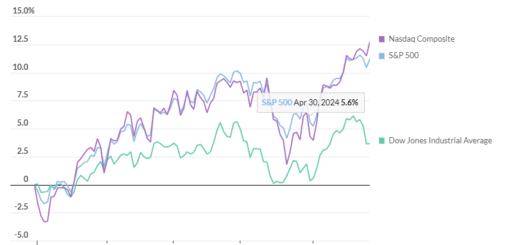Market’s Tug of War: Bond Yields vs. Stock Prices ??
On Wednesday, there was a continuation of the upward trajectory in Treasury yields, with the 10-year Treasury yield reaching 4.9% for the first time since 2007. This surge in yields had a corresponding impact on stock markets, causing a decline in their value.
Historical data suggests that as we approach the end of the year, stock markets tend to rally. However, the ongoing bond sell-off poses a significant threat to what has otherwise been a strong year for equity markets.
As investors divest themselves of bonds, their prices fall, and yields rise. The current sell-off in the bond market, combined with the looming milestone of a 5% yield on the 10-year Treasury, exerts a psychological pull on investors, reminiscent of how Dow 30,000 captivated them in 2020. But it’s not just the absolute level of yields that affects the markets; it’s the rapidity of the change in both prices and rates.
Traditionally, bonds are seen as the stable and unexciting component of a portfolio, often referred to as “risk-free” assets. However, the belief that the U.S. government will meet its financial obligations doesn’t guarantee that the value of these securities will remain constant, a lesson that investors are relearning during the Federal Reserve’s period of raising interest rates.
Adding to this, the Treasury market’s movements are occurring while the stock market’s performance remains narrowly focused on a small group of key stocks, now colloquially known as the “Magnificent Seven.” A note from Torsten Sløk, the chief economist at Apollo, reveals that the price-to-earnings (P/E) ratio for the S&P 493 (excluding Apple, Alphabet, Microsoft, Amazon, Meta, Tesla, and Nvidia) has remained relatively stable at around 19 throughout the year.
In contrast, the collective P/E ratio for this select group of stocks has increased by over 50%, rising from 29 to 45. This suggests that investors are becoming more enthusiastic about the prospects of a few companies while showing less interest in the majority.
Sløk points out the intriguing paradox that this overvaluation of tech stocks is happening in a year when long-term interest rates have significantly risen. Tech companies often have cash flows that extend far into the future, making them more vulnerable to increases in the discount rate. Consequently, Sløk questions the sustainability of the rally led by tech companies in light of the simultaneous rise in yields.
In conclusion, Sløk suggests that a significant adjustment is necessary, as the current situation appears inconsistent. Either stock prices must realign with prevailing interest rates, or long-term interest rates must adapt to match stock valuations. The uncertainty surrounding inflation could introduce various challenges and opportunities for stock markets and risk-taking, depending on how the outlook evolves.
For investors, the longer the surge in yields continues, the greater the risk that the Federal Reserve may make policy errors by either tightening too little or too much, potentially resulting in unintended consequences. The true impact of these potential consequences will only become clear with the benefit of hindsight.




